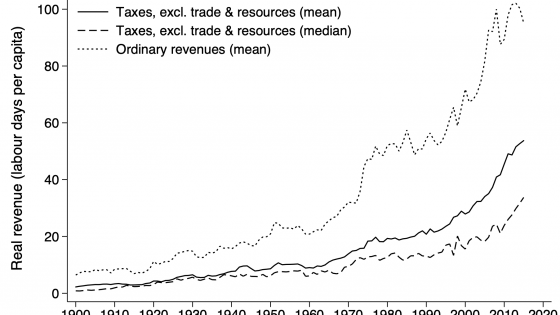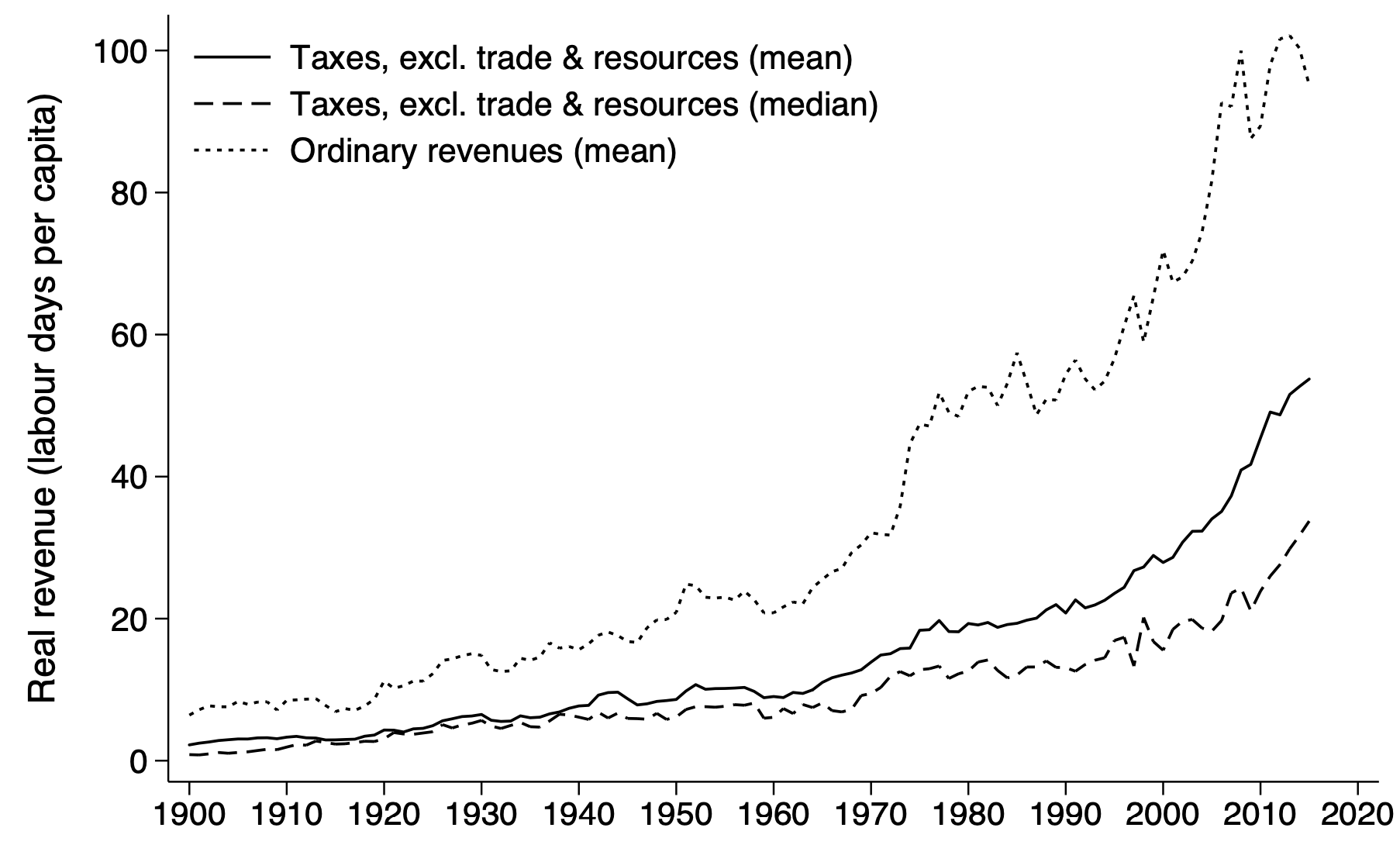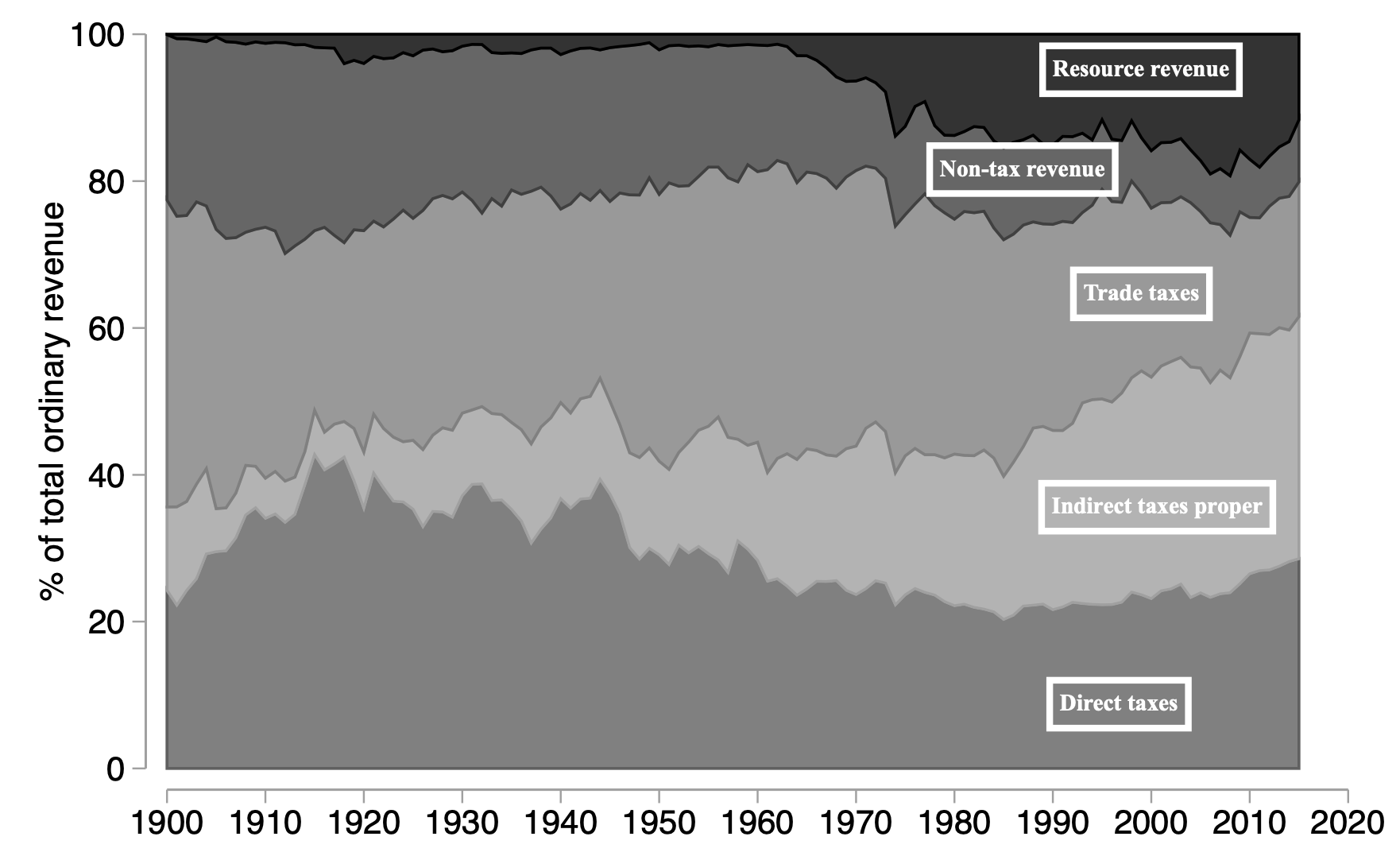Policymakers in developing countries know the importance of fiscal capacity well. Without the state possessing an adequate capacity to collect revenues, the provision of public goods, including schools, infrastructure, or security will be limited. Without these public goods, crucial preconditions for economic development are called into question (Besley and Persson 2014). It is not surprising therefore that development economists have focused on devising techniques to make the state in developing countries better at raising revenues (Pomeranz 2015, Ahlerup et al. 2015).
Yet we know surprisingly little about why fiscal capacity differs between developing countries. This is arguably due to a lack of data. While reasonably reliable data on current tax receipts exist, fiscal capacity is a dynamic, path-dependent process. In other words, current tax revenues are the result of decisions by past governments to invest in institutions that collect ‘hard’ taxes, such as income taxes (Besley et al. 2013). Unfortunately, comprehensive data on the evolution of tax collection for developing countries remains sparse. Does Nigeria today tax more today than it did 20, 30, 50 or 100 years ago, and more than South Africa did at those times? Previous datasets provide no direct answers to such questions.
Measuring the fiscal state in Africa
We have therefore collected and curated a unified database of tax revenues for all African polities from the establishment of the colonial state to the present (Albers et al.2020). This opens up a new basis from which to study this key group of developing countries. Figures 1 and 2 plot two descriptive statistics from our new data over time. Figure 1 shows our measure of fiscal capacity, namely, tax revenues excluding trade and resource income. We deflate nominal revenues by nominal wages to yield an estimate of real tax collection that is comparable across time and space. We show the mean level of tax revenue across all polities, as well as the median. Both lines picture a relatively strong pattern of growth- especially after independence (1960s) and most recently in the 2000s. Of course, growth in total revenues (the third line) is even higher, which is largely driven by resource income. This compositional change is visible in Figure 2, which displays the sources from which states in Africa gathered their revenue. The figure also shows that, while direct taxes were relatively important in colonial times, the recent boom in fiscal capacity is driven by the extension of indirect taxes (such as value added taxes).
Figure 1 Real tax and revenue levels in all African polities
Figure 2 Composition of revenue across all African polities
The descriptive evidence suggests that states in Africa have historically been able to increase their revenue-raising capacity. How have they been able to do so? We explore the influence of several factors on the growth of real tax revenues: democratisation, government turnover, and military conflict. We employ a panel specification with fixed effects at the country and year level after differencing the dependent variable, thus controlling for country-specific levels and trends in fiscal capacity.
Domestic factors: Democracy, conflict and government turnover
We find that democratic institutions can aid the build-up of fiscal capacity. However, this is only the case for ethnically relatively homogeneous polities. Democratisation exerted positive effects on fiscal capacity growth only if the voting population could ensure the excludability of unwanted beneficiaries from the receipt of public services. This is more likely to be the case in societies with limited ethnic fractionalization (Mkwandawire 2010).
The incentive of a government to invest in tax-collecting institutions may also be dependent on its time horizon. For example, autocrats (such as colonial rulers) could potentially sustain long periods of state-building if they regarded their position as sufficiently secure. We accordingly find that frequent government turnover can limit fiscal capacity, but only in non-democratic polities. In other words, autocratic rulers are unlikely to invest in tax collection if their rule is not expected to last.
A large literature outlines the role of war finance in leading to the creation of strong tax states in Europe. The literature on Africa has been sceptical of this mechanism, citing the lack of interstate conflict on the continent (Herbst 2000). However, we show that wars fought by colonisers, including the two World Wars, did lead to an extension of direct taxation in many African colonies. Our interpretation is that colonisers used their political clout to shift the tax burden to African populations – after independence, the correlation between war and state-building disappears.
Access to non-tax finance: Debt, aid, and resources
One of the ways in which state-building in developing countries may be hampered is through the greater availability of alternative sources of finance (Moore et al. 2018). Modern governments can draw on a variety of debt instruments, foreign aid, as well as resource revenues. This reduces the incentive to invest in direct taxation. Our results suggest that, as expected, the uptake of debt and foreign aid leads to a lower subsequent growth in real tax revenues. Of course, reverse causality could confound the picture, as we would expect fiscally precarious governments to resort to debt and aid more readily. We therefore use plausibly exogenous variation in global interest rates and colonial market rules to proxy access to debt. We model access to foreign aid through political and military alliances. The results show that access to aid and debt can indeed be powerful barriers to the development of fiscal capacity.
Finally, the dependence of African governments on resource revenues is often singled out to explain the supposed weakness of African institutions. In order to test this proposition, we have collected new data on global commodity prices and the export structure of African economies. Using the exogenous variation in a country’s resource income provided by world price movements, we show that higher resource revenues do not lead to lower growth in direct tax revenues. Only for oil-producing countries is there evidence of some substitution between resource income and fiscal capacity building. While this shows that accounts of a ‘resource curse’ may be appropriate for subsets of countries and commodities, our results caution against taking the experience of oil producing countries as representative for a broader group of African economies.
References
Ahlerup, P, T Baskaran and A Bigsten (2015), “Tax innovations and public revenues in sub-Saharan Africa”, The Journal of Development Studies 51(6): 689–706.
Albers, T, M Jerven and M Suesse (2020), “The Fiscal State in Africa: Evidence from one Century of Growth”, African Economic History Working Paper 55/2020.
Besley, T and T Persson (2014), “Why do developing countries tax so little?”, Journal of Economic Perspectives 28(4): 99–120.
Besley, T, E Ilzetzki, and T Persson (2013), “Weak states and steady states: The dynamics of fiscal capacity”, American Economic Journal: Macroeconomics 5(4): 205–35.
Cogneau, D, Y Dupraz, and S Mesplé-Somps (2018), “Fiscal capacity and dualism in colonial states: The French Empire 1830-1962”, Technical Report 2018-27, PSE Working Papers.
Frankema, E and M van Waijenburg (2014), “Metropolitan blueprints of colonial taxation? Lessons from fiscal capacity building in British and French Africa, c. 1880-1940”, The Journal of African History 55(3): 371–400.
Herbst, J (2000), States and power in Africa: Comparative lessons in authority and control, Princeton Studies in International History and Politics. Princeton University Press.
Mansour, M (2014), “A tax revenue dataset for sub-Saharan Africa: 1980-2010”, Technical Report I19, Fondation pour les Études et Recherches sur le Développement International Working Papers.
Mkandawire, T (2010), “On tax efforts and colonial heritage in Africa”, The Journal of Development Studies 46(10): 1647–1669.
Moore, M, W Prichard and O-H Fjeldstad (2018), Taxing Africa: Coercion, Reform and Development, Zed Books.
Pomeranz, D (2015), “No taxation without information: Deterrence and self-enforcement in the Value Added Tax”, American Economic Review 105(8): 2539–69.
Endnotes
1 For example, despite promising recent work on individual country or period groupings in Africa (Mansour 2014, Frankema and van Waijenburg 2014, Cogneau et al. 2018), there exists no methodologically consistent database of long-run tax revenues for developing countries.
2 This African sample encompasses 46 countries comprising all currently sovereign countries of the African continent plus Madagascar, minus Equatorial Guinea, Eritrea and South Sudan. The included countries share important institutional commonalities, including colonial legacies and a heavy dependence on primary resources, while being highly heterogeneous in a number of interesting dimensions, such as exposure to military conflict and the building of democratic institutions.









